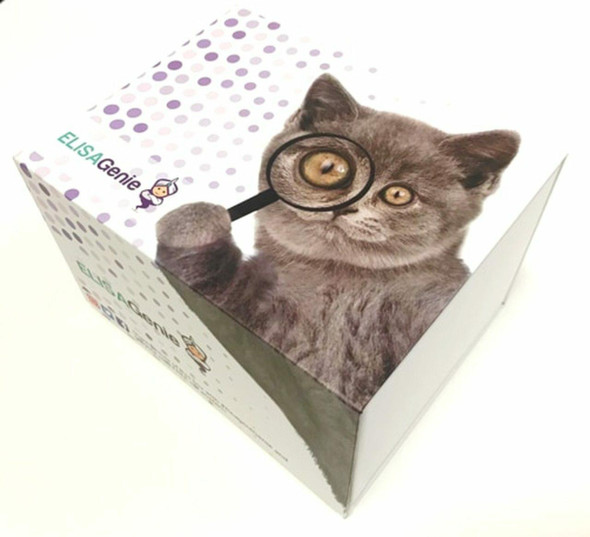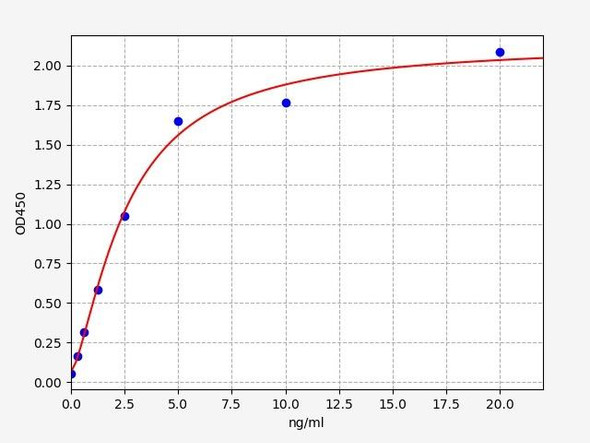Human Cell Biology ELISA Kits 1
Human SOD3 (Superoxide Dismutase 3, Extracellular) ELISA Kit (HUES03252)
- SKU:
- HUES03252
- Product Type:
- ELISA Kit
- Size:
- 96 Assays
- Uniprot:
- P08294
- Sensitivity:
- 3.75ng/mL
- Range:
- 6.25-400ng/mL
- ELISA Type:
- Competitive
- Synonyms:
- EC-SOD, Extracellular Superoxide Dismutase [Cu-Zn]
- Reactivity:
- Human
- Sample Type:
- Serum, plasma and other biological fluids
- Research Area:
- Cell Biology
Description
| Assay type: | Competitive-ELISA |
| Format: | 96T |
| Assay time: | 2.5h |
| Reactivity: | Human |
| Detection Method: | Colormetric |
| Detection Range: | 6.25-400 ng/mL |
| Sensitivity: | 3.75 ng/mL |
| Sample Volume: | 50µL |
| Sample Type: | Serum, plasma and other biological fluids |
| Specificity: | This kit recognizes Human SOD3 in samples. No significant cross-reactivity or interference between Human SOD3 and analogues was observed. |
This ELISA kit uses Competitive-ELISA as the method. The microtiter plate provided in this kit has been pre-coated with Human SOD3. During the reaction, Human SOD3 in the sample or standard competes with a fixed amount of Human SOD3 on the solid phase supporter for sites on the Biotinylated Detection Ab specific to Human SOD3. Excess conjugate and unbound sample or standard are washed from the plate, and Avidin conjugated to Horseradish Peroxidase (HRP) are added to each microplate well and incubated. Then a TMB substrate solution is added to each well. The enzyme-substrate reaction is terminated by adding Stop Solution and the color change is measured spectrophotometrically at a wavelength of 450 nm ± 2 nm. The concentration of Human SOD3 in the samples is then determined by comparing the OD of the samples to the standard curve.
| UniProt Protein Function: | SOD3: Protect the extracellular space from toxic effect of reactive oxygen intermediates by converting superoxide radicals into hydrogen peroxide and oxygen. Belongs to the Cu-Zn superoxide dismutase family. |
| UniProt Protein Details: | Protein type:EC 1. 15. 1. 1; Secreted, signal peptide; Oxidoreductase; Secreted Chromosomal Location of Human Ortholog: 4p15. 2 Cellular Component: extracellular matrix; extracellular space; Golgi lumen; cytoplasm; extracellular region; trans-Golgi network; nucleus Molecular Function:heparin binding; protein binding; copper ion binding; zinc ion binding; superoxide dismutase activity Biological Process: response to reactive oxygen species; response to copper ion; removal of superoxide radicals; response to hypoxia |
| NCBI Summary: | This gene encodes a member of the superoxide dismutase (SOD) protein family. SODs are antioxidant enzymes that catalyze the conversion of superoxide radicals into hydrogen peroxide and oxygen, which may protect the brain, lungs, and other tissues from oxidative stress. Proteolytic processing of the encoded protein results in the formation of two distinct homotetramers that differ in their ability to interact with the extracellular matrix (ECM). Homotetramers consisting of the intact protein, or type C subunit, exhibit high affinity for heparin and are anchored to the ECM. Homotetramers consisting of a proteolytically cleaved form of the protein, or type A subunit, exhibit low affinity for heparin and do not interact with the ECM. A mutation in this gene may be associated with increased heart disease risk. [provided by RefSeq, Oct 2015] |
| UniProt Code: | P08294 |
| NCBI GenInfo Identifier: | 108885292 |
| NCBI Gene ID: | 6649 |
| NCBI Accession: | P08294. 2 |
| UniProt Related Accession: | P08294 |
| Molecular Weight: | |
| NCBI Full Name: | Extracellular superoxide dismutase |
| NCBI Synonym Full Names: | superoxide dismutase 3 |
| NCBI Official Symbol: | SOD3 |
| NCBI Official Synonym Symbols: | EC-SOD |
| NCBI Protein Information: | extracellular superoxide dismutase [Cu-Zn] |
| UniProt Protein Name: | Extracellular superoxide dismutase [Cu-Zn] |
| Protein Family: | Sodium channel |
| UniProt Gene Name: | SOD3 |
| UniProt Entry Name: | SODE_HUMAN |
As the OD values of the standard curve may vary according to the conditions of the actual assay performance (e. g. operator, pipetting technique, washing technique or temperature effects), the operator should establish a standard curve for each test. Typical standard curve and data is provided below for reference only.
| Concentration(ng/mL) | O.D | Average |
| 400 | 0.396 0.42 | 0.408 |
| 200 | 0.521 0.533 | 0.527 |
| 100 | 0.743 0.723 | 0.733 |
| 50 | 1.036 1.044 | 1.04 |
| 25 | 1.426 1.41 | 1.418 |
| 12.5 | 1.788 1.78 | 1.784 |
| 6.25 | 2.06 2.072 | 2.066 |
| 0 | 2.459 2.463 | 2.461 |
Precision
Intra-assay Precision (Precision within an assay): 3 samples with low, mid range and high level Human SOD3 were tested 20 times on one plate, respectively.
Inter-assay Precision (Precision between assays): 3 samples with low, mid range and high level Human SOD3 were tested on 3 different plates, 20 replicates in each plate.
| Intra-assay Precision | Inter-assay Precision | |||||
| Sample | 1 | 2 | 3 | 1 | 2 | 3 |
| n | 20 | 20 | 20 | 20 | 20 | 20 |
| Mean (ng/mL) | 20.30 | 63.40 | 182.70 | 22.10 | 66.30 | 166.50 |
| Standard deviation | 1.30 | 2.70 | 5.70 | 1.20 | 3.00 | 7.20 |
| C V (%) | 6.40 | 4.26 | 3.12 | 5.43 | 4.52 | 4.32 |
Recovery
The recovery of Human SOD3 spiked at three different levels in samples throughout the range of the assay was evaluated in various matrices.
| Sample Type | Range (%) | Average Recovery (%) |
| Serum (n=5) | 93-108 | 99 |
| EDTA plasma (n=5) | 87-100 | 93 |
| Cell culture media (n=5) | 91-104 | 96 |
Linearity
Samples were spiked with high concentrations of Human SOD3 and diluted with Reference Standard & Sample Diluent to produce samples with values within the range of the assay.
| Serum (n=5) | EDTA plasma (n=5) | Cell culture media (n=5) | ||
| 1:2 | Range (%) | 99-112 | 90-101 | 86-101 |
| Average (%) | 105 | 96 | 93 | |
| 1:4 | Range (%) | 89-101 | 87-100 | 101-113 |
| Average (%) | 94 | 94 | 107 | |
| 1:8 | Range (%) | 88-98 | 87-99 | 96-107 |
| Average (%) | 93 | 94 | 102 | |
| 1:16 | Range (%) | 88-104 | 91-105 | 97-108 |
| Average (%) | 95 | 97 | 102 |
An unopened kit can be stored at 4°C for 1 month. If the kit is not used within 1 month, store the items separately according to the following conditions once the kit is received.
| Item | Specifications | Storage |
| Micro ELISA Plate(Dismountable) | 8 wells ×12 strips | -20°C, 6 months |
| Reference Standard | 2 vials | |
| Concentrated Biotinylated Detection Ab (100×) | 1 vial, 120 µL | |
| Concentrated HRP Conjugate (100×) | 1 vial, 120 µL | -20°C(shading light), 6 months |
| Reference Standard & Sample Diluent | 1 vial, 20 mL | 4°C, 6 months |
| Biotinylated Detection Ab Diluent | 1 vial, 14 mL | |
| HRP Conjugate Diluent | 1 vial, 14 mL | |
| Concentrated Wash Buffer (25×) | 1 vial, 30 mL | |
| Substrate Reagent | 1 vial, 10 mL | 4°C(shading light) |
| Stop Solution | 1 vial, 10 mL | 4°C |
| Plate Sealer | 5 pieces | |
| Product Description | 1 copy | |
| Certificate of Analysis | 1 copy |
- Set standard, test sample and control (zero) wells on the pre-coated plate and record their positions. It is recommended to measure each standard and sample in duplicate. Note: add all solutions to the bottom of the plate wells while avoiding contact with the well walls. Ensure solutions do not foam when adding to the wells.
- Add 50µL of Standard, Blank or Sample to their respective wells. The blank well is added with Sample / Standard dilution buffer.
- Immediately add 50 µL of Biotin-detection antibody working solution to each well.
- Cover with a plate seal and gently tap the plate to ensure thorough mixing. Incubate for 45minutes at 37°C.
- Aspirate or decant the solution from the plate and add 350µL of wash buffer to each welland incubate for 1-2 minutes at room temperature. Aspirate the solution from each well andclap the plate on absorbent filter paper to dry. Repeat this process 3 times. Note: a microplatewasher can be used in this step and other wash steps.
- Add 100µL of HRP Conjugate working solution to each well and over with a plate seal. Incubate for 30 minutes at 37°C.
- Repeat the aspiration/wash process 5 times according to step 5.
- Add 90µL of the Substrate reagent to each well and cover with a new plate seal. Incubatefor approximately 15 minutes at 37°C and protect from light. The reaction time can beshortened or extended according to the colour change, but not by more than 30 minutes. Whenapparent gradient appears in standard wells, terminate the reaction.
- Stop: Add 50µL of Stop Solution to each well (wells will develop a yellow color immediately). Note: Adding the stop solution should be done in the same order as the substrate solution.
- Determine the optical density (OD value) of each well immediately with a microplate readerset at 450 nm. In advance, preheat the instrument and set the testing parameters.




![Human Extracellular superoxide dismutase [Cu-Zn] (SOD3) ELISA Kit Human Extracellular superoxide dismutase [Cu-Zn] (SOD3) ELISA Kit](https://cdn11.bigcommerce.com/s-rd6ounxcu2/images/stencil/590x590/products/17851/21903/human-extracellular-superoxide-dismutase-cu-zn-sod3-elisa-kit__20453__28908.1706272621.jpg?c=1)

